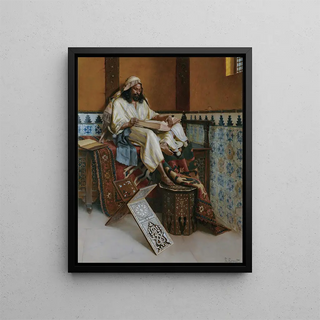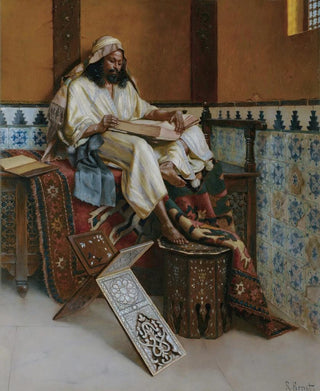Art print | The Scholar - Rudolf Ernst


View from behind

Frame (optional)
In the fascinating world of Orientalist art, the art print "L'érudit" by Rudolf Ernst stands out for its captivating atmosphere and meticulous attention to detail. This painting, which evokes a world that is both mysterious and scholarly, transports the viewer into a universe where wisdom and beauty meet. The artist, by capturing the essence of a scholar immersed in his studies, succeeds in evoking reflection on knowledge, learning, and the pursuit of truth. The scene, rich in colors and textures, embodies a moment of contemplation, where each element contributes to creating an ambiance conducive to meditation.
Style and uniqueness of the art print
Rudolf Ernst's style is deeply rooted in the Orientalist movement, but it often transcends the conventions of his time. In "L'érudit," one observes an impressive mastery of light and shadow, which gives the scene depth and emotional intensity. The meticulous details of clothing, objects, and decorative motifs demonstrate a refined aesthetic pursuit. The colors are used with delicacy, evoking the warmth and richness of Eastern cultures. The artist manages to create a harmonious balance between realism and a certain poetry, allowing the viewer to fully immerse themselves in the universe he has shaped. The composition, centered on the scholar, draws the eye and invites a visual exploration of the surrounding elements, revealing hidden stories behind each object.
The artist and his influence
Rudolf Ernst, born in 1854 in Vienna, was an artist whose career was marked by a fascination with Eastern cultures. His work reflects a journey through exotic landscapes and rich traditions, which he translated with sensitivity and precision. Influenced by masters such as Jean-Léon Gérôme, Ernst developed a unique style, combining realism and romanticism. His work helped popularize Orientalism in Europe in the 19th century, while also sparking growing interest in non-Western arts and cultures. Through "L'érudit," he manages to capture the essence of an era when the East was perceived as a

Matte finish

View from behind

Frame (optional)
In the fascinating world of Orientalist art, the art print "L'érudit" by Rudolf Ernst stands out for its captivating atmosphere and meticulous attention to detail. This painting, which evokes a world that is both mysterious and scholarly, transports the viewer into a universe where wisdom and beauty meet. The artist, by capturing the essence of a scholar immersed in his studies, succeeds in evoking reflection on knowledge, learning, and the pursuit of truth. The scene, rich in colors and textures, embodies a moment of contemplation, where each element contributes to creating an ambiance conducive to meditation.
Style and uniqueness of the art print
Rudolf Ernst's style is deeply rooted in the Orientalist movement, but it often transcends the conventions of his time. In "L'érudit," one observes an impressive mastery of light and shadow, which gives the scene depth and emotional intensity. The meticulous details of clothing, objects, and decorative motifs demonstrate a refined aesthetic pursuit. The colors are used with delicacy, evoking the warmth and richness of Eastern cultures. The artist manages to create a harmonious balance between realism and a certain poetry, allowing the viewer to fully immerse themselves in the universe he has shaped. The composition, centered on the scholar, draws the eye and invites a visual exploration of the surrounding elements, revealing hidden stories behind each object.
The artist and his influence
Rudolf Ernst, born in 1854 in Vienna, was an artist whose career was marked by a fascination with Eastern cultures. His work reflects a journey through exotic landscapes and rich traditions, which he translated with sensitivity and precision. Influenced by masters such as Jean-Léon Gérôme, Ernst developed a unique style, combining realism and romanticism. His work helped popularize Orientalism in Europe in the 19th century, while also sparking growing interest in non-Western arts and cultures. Through "L'érudit," he manages to capture the essence of an era when the East was perceived as a






